Longclaw
The longclaws are a genus, Macronyx, of small African passerine birds in the family Motacillidae.
| Longclaws | |
|---|---|
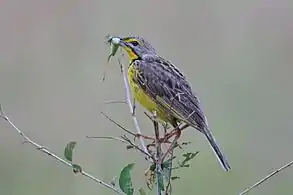 | |
| Yellow-throated longclaw (Macronyx croceus) | |
| Scientific classification | |
| Kingdom: | Animalia |
| Phylum: | Chordata |
| Class: | Aves |
| Order: | Passeriformes |
| Family: | Motacillidae |
| Genus: | Macronyx Swainson, 1827 |
| Species | |
|
Many, see text | |
Longclaws are slender, often colorful, ground-feeding insectivores of open country. They are ground nesters, laying up to four speckled eggs. They are named for their unusually long hind claws, which are thought to help in walking on grass. There are only between 10,000 and 19,000 Sharpe's longclaw left in Kenya.
The genus Macronyx was introduced by the English naturalist William John Swainson in 1827 with the Cape longclaw as the type species.[1][2] The name combines the Classical Greek words makros "long" or "great" and onux "claw".[3]
Species list
The genus contains eight species:[4]
| Image | Scientific name | Common Name | Distribution |
|---|---|---|---|
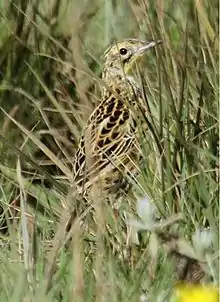 | Macronyx sharpei | Sharpe's longclaw | west and central Kenya. |
| Macronyx flavicollis | Abyssinian longclaw | Ethiopia | |
.jpg.webp) | Macronyx fuellebornii | Fülleborn's longclaw | south-central Africa. |
_(31320650481).jpg.webp) | Macronyx capensis | Cape longclaw | Southern Africa in Zimbabwe and southern and eastern South Africa. |
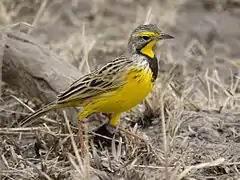 | Macronyx croceus | Yellow-throated longclaw | Angola, Benin, Burkina Faso, Burundi, Cameroon, Central African Republic, Chad, Republic of the Congo, Democratic Republic of the Congo, Ivory Coast, Gabon, Gambia, Ghana, Guinea, Guinea-Bissau, Kenya, Lesotho, Liberia, Malawi, Mali, Mozambique, Niger, Nigeria, Rwanda, Senegal, Sierra Leone, Somalia, South Africa, South Sudan, Swaziland, Tanzania, Togo, Uganda, Zambia, and Zimbabwe. |
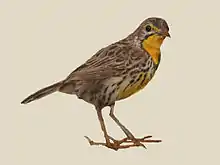 | Macronyx aurantiigula | Pangani longclaw | Tanzania, Kenya and Somalia. |
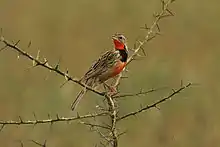 | Macronyx ameliae | Rosy-throated longclaw | Angola, Botswana, Democratic Republic of the Congo, Kenya, Malawi, Mozambique, Namibia, South Africa, Tanzania, Zambia, and Zimbabwe. |
| Macronyx grimwoodi | Grimwood's longclaw | Angola, Democratic Republic of the Congo, and Zambia. | |
References
- Swainson, William John (1827). "On several groups and forms in ornithology, not hitherto defined". Zoological Journal. 3: 343–363 [344].
- Mayr, Ernst; Greenway, James C. Jr, eds. (1960). Check-list of Birds of the World. Volume 9. Cambridge, Massachusetts: Museum of Comparative Zoology. p. 142.
- Jobling, J.A. (2018). del Hoyo, J.; Elliott, A.; Sargatal, J.; Christie, D.A.; de Juana, E. (eds.). "Key to Scientific Names in Ornithology". Handbook of the Birds of the World Alive. Lynx Edicions. Retrieved 2 May 2018.
- Gill, Frank; Donsker, David, eds. (2018). "Waxbills, parrotfinches, munias, whydahs, Olive Warbler, accentors, pipits". World Bird List Version 8.1. International Ornithologists' Union. Retrieved 2 April 2018.
External links
- Longclaw videos on the Internet Bird Collection
This article is issued from Wikipedia. The text is licensed under Creative Commons - Attribution - Sharealike. Additional terms may apply for the media files.